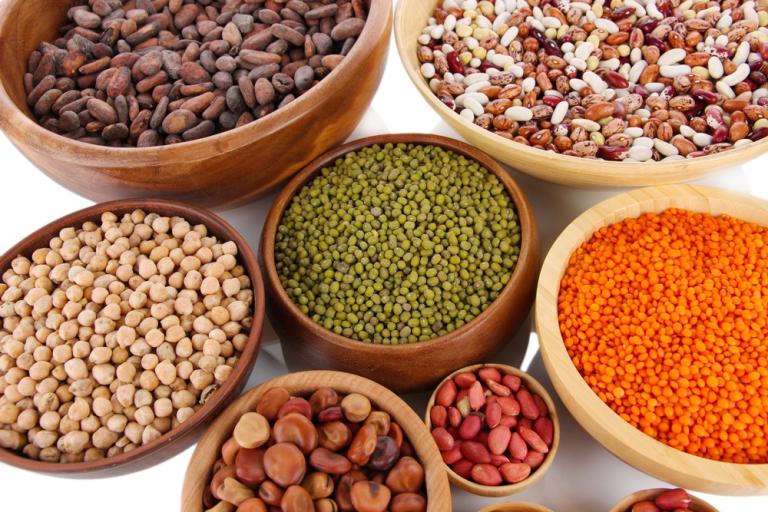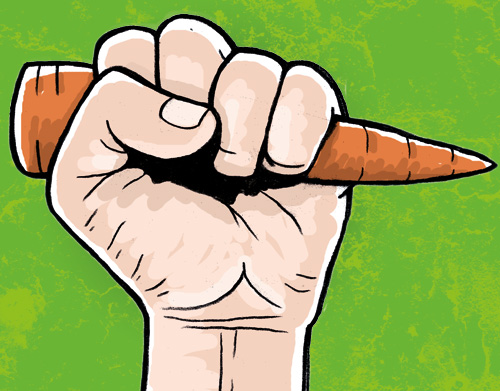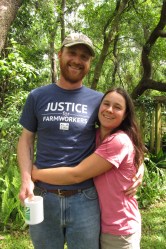
Siena Chrisman, WhyHungerBob St. Peter and Juli Perry.
Bob St. Peter and his wife, Juli Perry, farm four acres in coastal Maine, growing vegetables, herbs, flowers, rabbits, chickens, and sheep to feed their family and their neighbors. They grow food in ways that build rich soil, nurture wildlife, and nourish their community. But “at the end of the day,” Bob says, “we’ve been bewildered at how hard it is to produce food to feed people.”
Not because of the intrinsic challenges of weather, pests, or the hard work involved, but because of the colossal wall of systemic market forces stacked against the profession of farming — and especially against farmers starting from scratch who want not to grow commodity crops or sell vegetables to high-end restaurants, but simply to feed people.
Bob’s not the only one fighting this uphill battle; so, too, are the small-scale dairy farmers wondering if each day milking their 40 cows might be the last; ranchers watching their options for a fair price on their cattle dwindle as meatpackers consolidate; farmworkers making sub-poverty wages for backbreaking work in the fields; and food workers unable to take a sick day without fear of losing their jobs.
“I sell my chicken for $4 a pound — because that’s what it costs me to produce it,” Bob says. “But people think that’s expensive, because you can get chicken at the grocery down the road for 79 cents a pound.”
When Bob looks at the supply chain leading to 79-cents-a-pound chicken, he sees contract poultry growers deep in debt to huge corporations, chickens pumped full of antibiotics and growth hormones, workers with crippling injuries from keeping up on the poultry processing line, and consumers exposed to increasing food-borne disease outbreaks. When food is sold for prices that ignore these external costs, everyone in the line of production suffers — and those, like Bob, who are trying to produce food in a way that is good for the land, workers, and local economy, can barely survive.
“As a small farmer,” he says, “I’m competing with a system that produces food based on slavery and exploitation.”
Voting with your fork — buying chicken raised in ways you believe in, or knowing the name and growing practices of your kale farmer — helps to support the farmers you’re buying from, but it doesn’t change the challenging context in which they’re struggling to make a living. “Wanting access to healthier food,” as so many people do, Bob says, “isn’t the same as creating the infrastructure to provide it.”
Bob points to a “frontline of people who want to feed the world” rebuilding that infrastructure from scratch — new farmers like himself, farmers and fishers from old families who fear they will be the last to work the land or the sea, farmworkers and food workers putting in long hours to feed their families. They face many of the same problems — but as often as not, they are divided against each other. Farmers facing rising costs of fertilizer or equipment look for savings by cutting workers’ wages; farmworkers are under such pressure from farm owners to meet a production quota that they feel they cannot take breaks without fear of losing their jobs.
What if instead they worked together? Farmers coming together with farmworkers, sharing lessons learned about how to transform their industry and hold major corporations accountable. Farmers and food-industry workers talking to consumers about the economic and policy issues shaping the system — and encouraging them to vote with their political power as well as with their fork.
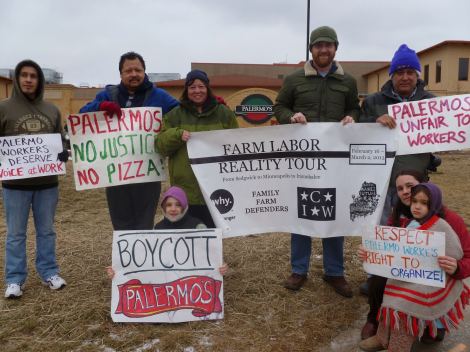
Bob St. Peter (second from left) and his family joined striking Palermo’s Pizza workers on a picket line in Milwaukee in the first week of the Farm Labor Reality Tour.
It was with this goal in mind that Bob, Juli, and their two daughters hit the road in March for the Farm Labor Reality Tour. For Bob, it was imperative to connect with farm laborers, learn about their struggles and see their achievements firsthand, and strategize with them on opportunities for solidarity. The family traveled from Maine to the Midwest to meet with dairy farmers from Wisconsin-based Family Farm Defenders, and then to Florida to participate in the Coalition of Immokalee Workers’ two-week, 200-mile March for Rights, Respect, and Fair Food.
What they found along the way was that across the food chain, workers are eager to connect. In Milwaukee, the family joined striking food-service workers on the picket line, and Bob spoke at a town hall forum on immigration reform — an issue important to many farm and food workers. In Minneapolis, Bob was part of two panel discussions with dairy farmers, labor rights advocates, students, and urban farmers. He learned about a campaign targeting big Minnesota dairy farms to stop wage theft, and for the first time truly understood how a system that pits farmers and workers against each other can also unite them to work for common goals.
In Florida, Bob’s family walked the whole 200 miles of the March for Rights, Respect, and Fair Food with the CIW. The march drew thousands of people calling on grocery giant Publix to help end farmworker exploitation by joining the innovative Fair Food Program. The program — a collaboration between Florida’s tomato growers, major retailers, and farmworkers — sets the standard for social accountability in the domestic produce industry by guaranteeing basic rights like payment for time worked, access to water, shade, and bathrooms in the fields, and the right to work free from sexual harassment — all rights regularly denied to farmworkers. McDonald’s, Burger King, Taco Bell, and eight other major fast food corporations and food companies have signed onto the Fair Food Agreement, which has begun to dramatically change the lives of farmworkers in Florida’s tomato fields.
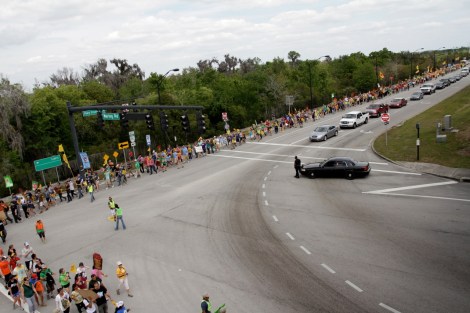
Jake Ratner / Just HarvestThe March for Rights, Respect, and Fair Food, in its final day.
The seeds for the Farm Labor Reality Tour were planted last summer in Maine, when Bob and his organization, Food for Maine’s Future — a grassroots group working to build a sustainable and democratic food system in Maine — invited the CIW to help kickstart a project to bring together beginning Maine farmers who grow high-quality produce and migrant blueberry pickers facing limited access to healthy food. The project joins these two struggling groups around a dinner table, with food as both necessary nourishment and as a tool for broader strategizing and organizing.
Conversations begun in the blueberry fields were broadened and formalized in the following months through a peer mentoring relationship between the two organizations and Family Farm Defenders, supported by national grassroots support organization WhyHunger. Inspired by the success of the CIW’s Fair Food Campaign, and interested in building a campaign for fair prices for dairy farmers, Maine and Midwestern farmers visited Immokalee to learn more, while the CIW saw the relationship as an opportunity to learn about the challenges facing small farmers and build new alliances for their campaign.
After a year of partnership and solidarity building, Florida made for an appropriate final leg of the tour. Just as the CIW made a splash in Maine, Bob and his family — and Wisconsin dairy farmers who arrived to march the final few days — drew attention in Florida. While alliance building is nothing new to the CIW, the presence of independent farmers — taking hard-to-spare time away from their cows or spring planting because they believe they share a common struggle and common fate — was particularly notable.
On the final mile of the march, dozens of CIW members, faces weathered from years in the fields, carried a CIW banner to Publix headquarters. A column of more than 1,500 people of all ages, races, and backgrounds stretched behind them. The CIW has demonstrated the power of students, faith leaders, and food justice organizations standing alongside some of the most marginalized people in the food system. That power that has drawn concessions from some of the biggest corporations in the world, but much more remains to be done.
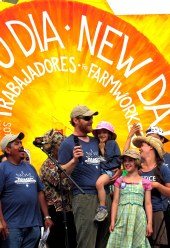
Siena Chrisman, WhyHungerBob St. Peter with his family and Lucas Benitez of the CIW at the closing rally of the March for Rights, Respect, and Fair Food.
“Farmers and farmworkers won’t be divided against each other any longer,” said Bob at the closing rally of the march. “For too long we’ve been fighting over crumbs. We want a bigger piece of the pie.”
The 6,500 miles of the Farm Labor Reality Tour shone a bright light on the harsh realities of a system that lets consumers pay 79 cents a pound for chicken without knowing about all the exploitation that goes along with it. “We need a new direction for the food movement,” Bob says. “We need to figure out how we’re going to address human rights and fair wages, so that the people who are providing basic foods for our country can have a decent, good life.”
The CIW march and the connections made on the tour make clear who will lead the way. “As farmworkers, food workers, and family farmers, we have a natural affinity,” Bob says. “And once we all get together, we’re unstoppable.”
